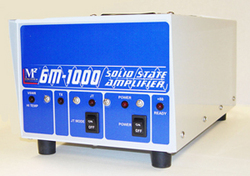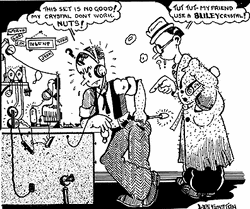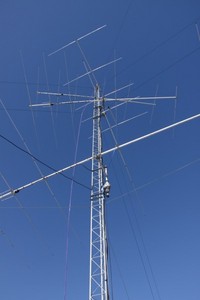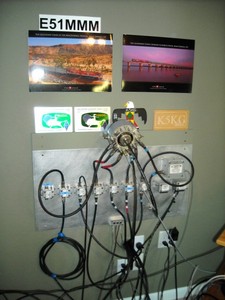 March 30, 2011 Editor: Ward Silver, NØAX | ||||||
IN THIS ISSUE
NEW HF OPERATORS - THINGS TO DO For those of you getting your feet wet in the world of CW, the QRP Amateur Radio Club's Spring QSO Party is a great mid-to-low speed exercise for your sending and receiving skills alike. While you can participate in the QRO class, if you dare, turn down the power on your rig and prepared to be surprised! BULLETINS You HAVE filed your comments on HR 607, haven't you? BUSTED QSOS So months with five weekends come more frequently than every 823 years as suggested in the last issue. Your editor will serve 823 seconds in the Contest Update penalty box for insufficient skepticism and lack of due diligence. Five-weekend months do play hob with contest scheduling, though. (Thanks, Tom N1MM) Also, it was David N6AN (not N6EN) who gets credit for the California QSO Party item in the previous issue. (Thanks, Paul N6LL) CONTEST SUMMARY Complete information for all contests follows the Conversation section April 2-3
April 9-10
NEWS, PRESS RELEASES, AND GENERAL INTEREST
We have several new products of interest to VHF+ contesters for the coming summer VHF+ contest season. First, M2 has a brand-new solid-state kilowatt 6 meter amplifier, the 6M-1000. 80 watts of input power will produce the full output so your all-band radio should be able to do the job. A 2 meter version is reportedly in the works, as well. At a slightly lower output power, Kanga US has new 6 and 2 meter converter kits, plus CW source kits for 6 and 2 meters designed by Rick KK7B. And finally, take a look at the Fall 2010 issue of CQ-VHF for a 70 cm tracking beacon by WC5Z. The ill-advised proposal to "re-purpose" some of the amateur 70 cm privileges is deflecting amateur attention from another possible use of spectrum for broadband networking. The LightSquared company is proposing to place high-power microwave transmitters adjacent to the GPS downlink frequencies, something that is very alarming to the GPS community. As hams know well, if strong enough even a perfectly clean signal will cause overload problems in an insufficiently selective receiver. With GPS being a key navigation technology this issue bears watching as it continues to evolve. Hams should be sure to use their frequency allocations because the inquisitive souls at Microsoft have devised a system for measuring whether licensed radio frequencies are being used by those who own the rights to the spectrum. I wonder if this tool could be used to find a clear run frequency during major contests? (Thanks, Bill W7KXB) NASA has launched a program to develop spaceflight kits for high school teachers and students to build and fly on sub-orbital flights. As reported in the 27 March AMSAT bulletin ANS-086.07, "NASA says its Emerging Commercial Space Office (ECSO) is teaming with Make Magazine, and Teachers in Space to help develop spaceflight kits that high school teachers and students can build and fly on suborbital flights." The rules have been published by Make and proposals are due by the end of April. The broadcast band seems to have been around since KDKA first went live in 1920 but it did not always have its present configuration. On 29 March 1941, channel assignments underwent a grand shuffle, creating clear-channel frequencies and reserving others for local use. The top end of the "BC Band" moved higher to 1600 kHz, as well.
Pileup! editor, Ilkka OH1WZ writes to encourage contributions to this free, on-line talkoo (joint-work) journal. The next issue is to be released at the end of May - if you have an idea for an article, contact Ilkka or his co-editors, OH7WV and OH6KZP. Each issue has hundreds of readers in the US, Canada, Europe, and beyond! (Contact the editors at call_sign@sral.fi.) Another online magazine is ready for your inspection, as well. The April 2011 edition of WorldRadio Online magazine is live. Among other things, well-known propagation author and contester Carl K9LA writes the "Propagation" column - always a good read. (Thanks, Editor Richard KI6SN) This week's Science News included an article about sunspots, in which it is expected that the cycle will peak on schedule in 2013 or 2014 and average activity will remain in the doldrums for a while. It's that darn meridional flow, apparently! (Thanks, Bob KY7O) Both Spock (Leonard Nimoy) and Captain Kirk (William Shatner) turned 80 during the past week - do they still blow out candles on those far-off star dates or just deactivate the photon emitters? The New York QSO Party has changed some of its rules regarding mobile operation. Writes sponsor representative, Paul K2DB, "We have decided that there needed to be more clarification on the Mobile Category. With research and feedback, we decided that we needed to add another category to the Class Entries." See the NYQP web site for more information. Mike Koss W9SU, owner of Industrial Communications Engineers, Ltd. (ICE) passed away suddenly this past weekend. There is no word on the cause or on the status of ICE at this point - watch the ICE website for more information. ICE was widely known for its popular products - Mike will be missed. (Thanks, Tim K3LR) The Zeroland QSO Party, scheduled for May 7 and 8, has been canceled. Not to worry, that same weekend is host to the 7th District QSO Party, the New England QSO Party, and the Nevada and Indiana QSO Parties, 14 states worth of QSO party fun. Web Site of the Week - The National Institute of Standards and Technology, Time and Frequency Division is conducting an online survey of radio users. Many of us rely on these broadcasts for calibration (and to know when to start mashing the F1 key!) so be sure to log in and show that the service is appreciated. (Thanks, Mike W9RE) WORD TO THE WISE Frog - from a popular electrical engineering dictionary, "the top of a tower". Who knew? So I guess we have to put the plastic owl on top of the frog to get rid of crows and find True North! Be careful when you are standing on your frog! SIGHTS AND SOUNDS
Ken K4ZW has posted a nice album of photos from his recent trip to Mongolia, JT. If you worked JT5DX on the low bands this past season, here are the antennas responsible. (Thanks, Dave NN1N) Valery R5GA has been getting good reviews for his score-reporting web site. He is also collecting links to YouTube videos about contest operations and they are fun to watch! A beautiful compilation of time-lapse photography featuring the aurora borealis by Terje Sorgjerd is on-line for you to enjoy. (Thanks, John VA7OTC) The online package of 2010 ARRL CW Sweepstakes results are now up and ready for you, including PDF line scores and log-checking reports (LCRs). (Thanks, ARRL Contest Branch Manager, Sean KX9X) Next weekend's Montana QSO Party features an on-line scoring web page. After the contest, upload your contact totals and multipliers along with your logs and dupe sheets for verification. Once everything has been uploaded, you'll see your results instantly displayed. (Thanks, Ken KØPP)
The results of the NY QSO Party are finished and published. From the same link, you can also link to the certificate winners. (Thanks, Paul K2DB) Results of the 2010 MM All America Contest are online, including the scores of 1164 participants; 342 from South America and 822 from North America. (Thanks, Luc PW7T) Pre-publication results for last weekend's RTTY Sprint are now online as well. Individual LCRs (Log Check Reports) can be requested by email. (Thanks, NCJ NA RTTY Sprint Manager, Ed WØYK) Bob KØRC reports that he has, "completed the programming for a new BARTG HF Contest Log Analyzer and posted it to my web site." The downloadable spreadsheet tool is based on Excel 2003 but should work with any version, including the alternate Sun product called Open Office Calc. OPERATING TIP If you are a guest operator at a home station, don't forget to say thanks to the host family along with the ham who invited you! While they may not have built the station, their hospitality is important to your success. Thomas NZ4O writes to let us know that, "I have dropped the LF and MF aspect of my seven day radiowave propagation forecast due to low demand. In place of it I now produce a condensed version of my HF radiowave propagation forecast. I publish it every Friday morning at 0000 UTC on my SolarCycle24.org Facebook web page, my Solar Cycle 24 web page, and on my HF/6M Radiowave Propagation Forecast eGroup on Contesting.com. It is also published later in the day at eHam.net, QRZ.com and Southgate ARC. My complete HF/6M radiowave propagation and lightning QRN forecast is still available on the Solar Cycle 24 web page in section 3B." "Hackerspaces" are popping up all over, such as LVL1 in Louisville, Kentucky. The group includes several hams and has the club call sign N1LVL! Take a look at the web site for all the projects they have going on, including the launch of a balloon to Europe! (Thanks, George K5KG) Paul K2DB has uploaded a video showing how the CW reverse beacon network works using his remote station. It shows how quickly he can get to stations with the packet CW skimmer Reverse Beacon Network. Click on the right side of the home page under Main Pages on the RDXA Library link, then Tutorials and Presentations, click on Remote CW Skimmer Demo. When you get on the air on CW and call CQ, you can run but you cannot hide! The book "Storage Batteries - Including Operation, Charging, Maintenance and Repair" by G Smith is highly recommended by Frank VK2AKG. It's a good tutorial, now in its 3rd edition, on how to take care of those expensive backup power sources! Tower-mounted standoffs help keep coax from getting caught in a crankup tower or just hold them away from your tower legs. Bob K6UJ recommends standoffs from KF7P, particularly the curved standoff for supporting a dangling cable.
Jim W7RY provides this link to professional grounding guidelines. He also recommends the Motorola R56 Site Ground Standards and Tom W8JI's material on grounding. Yes sir, yes sir, three bags full - well, most tower bases take more concrete than that. How many do you need, anyway? Mickey N4MB uses this simple online calculator to get the answer. He cautions the user that while almost all the input values are in feet, the depth is entered in inches! Base loading an antenna to resonate on 160 meters or 80 meters can be tricky. Phil AD5X has addressed the subject from the perspective of his 43-foot vertical antenna. There's good information in the article you can apply to many similar needs. (Thanks, Al AB2ZY) Teflon is not supposed to stick to anything - so how can you glue it or attach it to something? Lars LA7SL recommends this special adhesive and David G4FTC the Loctite products 406 adhesive and 770 primer. Ulf SMØNOR takes a shorter path and suggests the bondable Teflon sheet from Small Parts. Technical Web Site of the Week - Remember "mill copy" and the clackety-clack as the typewriter keys hammered out another radiogram? I'll bet you can smell that typewriter oil right now! Well, that old manual or electric you just can't quite bear to part with does have a place in this digital age - but you have to convert it to use USB as described in this IEEE Spectrum article about a conversion kit from hackerspace Hive 76. Radiation and Radio With so much concern over the damaged nuclear reactors in Japan, sensitivity to the word "radiation" is very much higher than usual. In general, the public is not aware of the many meanings of the word nor are they sensitive to the differences in types of radiation. Since hams use electromagnetic radiation to communicate, it behooves us to be able to coherently explain why "our" radiation is OK and not a threat to others. Radio waves are non-ionizing radiation that does not contain sufficient energy to separate electrons from atoms and create ions. That effect only occurs at frequencies orders of magnitude higher than for radio signals. As you learned during your licensing studies, radio frequency energy only results in thermal (heating) effects to the body. The amount of heating depends on the frequency and power levels involved. Radio waves have not been shown to cause biological effects, such as genetic damage or cancer. Radiation from nuclear sources, such as radioactive substances, can cause biological effects because it is ionizing radiation. Furthering the confusion, the word "hot" is used to refer to both thermally hot and radioactive materials. Radioactivity can heat up materials (the inside of the Earth is kept hot from radioactive decay) but not vice versa. Only ionizing radiation from radioactive materials has enough energy to cause significant health hazards. Exposure to ionizing radiation is measured in sieverts - a term unfamiliar to most people. Because it is an unfamiliar measurement, we find it difficult to assess the importance of numeric values. Normal background levels of ionizing radiation are so low that even a small release of radioactivity can cause a change that sounds alarmingly high. Here is an excellent chart that gives some perspective to exposure. The current one-day dose of radiation near the plants (at the moment) is shown at the left of the green part of the chart. Additional discussion and references can be found here in this blog entry. For those of you living in the mountains or taking lots of airplane rides, this information may be a bit of a surprise! An explanation of permitted versus recommended levels of ionizing radiation was also discussed in an NPR interview on Mar 21st with Dr. Harold Swartz, professor of radiology and medicine, Dartmouth College. A transcript of that interview is available online and may be of interest in explaining the relative numbers we are encountering. Risk from exposure to radiation is not an easy thing to quantify in a single, brief statement. There are many factors involved and it is rare that we have all of the data or the expertise to evaluate that risk. Nevertheless, since we work with "radiation" every time we get on the air, it's important to be able to help our families and neighbors distinguish between what does and does not constitute a risk. 30 March through 12 April An expanded, downloadable version of QST's Contest Corral in PDF format is available. Check the sponsor's Web site for information on operating time restrictions and other instructions. HF CONTESTS Poisson d'Avril--operate ala mode, from Apr 1, 0000Z to, well, it doesn't really matter even though K1DG isn't entering this year. Bands: all-male Fleetwood Mac, you might disagree, but the sponsor gets to choose. Frequencies: all of them, get busy. Exchange: appropriate gifts, something tasteful but not too expensive. Logs due: too late - see the Rules. And here. But not here. Second Class Operators CW Bash--CW, from Apr 2, 0000Z to Apr 2, 2359Z. Bands (MHz): 3.5-28. Frequencies: QRP calling frequencies. Exchange: SOC member number, name, and RST. Logs due: Apr 16. Rules LZ Open 40 Meter Contest--CW, from Apr 2, 0400Z to Apr 2, 0800Z. Bands (MHz): 7. Exchange: 6-digit serial and serial from previous QSO. Logs due: 10 days. Rules QRP ARCI Spring QSO Party--CW, from Apr 2, 1200Z to Apr 3, 2400Z . Bands (MHz): 1.8-28. Frequencies: QRP calling frequencies. Exchange: RST, S/P/C, power or QRP ARCI number. Logs due: 30 days. Rules SP DX Contest--Phone,CW, from Apr 2, 1500Z to Apr 3, 1500Z . Bands (MHz): 1.8-28. Exchange: RS(T), serial or SP province. Logs due: Apr 30. Rules EA RTTY Contest--Digital, from Apr 2, 1600Z to Apr 3, 1600Z . Bands (MHz): 3.5-28. Exchange: RST, serial or EA province. Logs due: Apr 23. Rules MO QSO Party--Phone,CW, from Apr 2, 1800Z to Apr 3, 0500Z and Apr 4, 1800Z to Apr 4, 2359Z. Bands (MHz): 1.8-28. Frequencies: Multiple operating periods; CW 1.820 and 40 kHz from band edge; Phone--1.880, 3.825, 7.220, 14.250, 21.380, 28.350. Exchange: RS(T), serial, MO county or S/P/C. Logs due: May 3. Rules QCWA Spring QSO Party--Phone,CW,Digital, from Apr 2, 1800Z to Apr 3, 1800Z . Bands (MHz): 1.8-28, 50+. Exchange: Call,year lic'd,name,QCWA chap or S/P/C. Logs due: 30 days. Rules ARS Spartan Sprint--CW, from Apr 5, 0200Z to Apr 5, 0400Z. Bands (MHz): 3.5-28. Frequencies: Monthly on the first Monday evening local time. Exchange: RST, S/P/C, and power. Logs due: 2 days. Rules SNS and NS Weekly Sprints--CW, from Apr 8, 0200Z to Apr 8, 0300Z. Bands (MHz): 1.8-14. Frequencies: Weekly on Thursday evenings local time. Exchange: Serial, name, and S/P/C. Logs due: 2 days. Rules EU Spring Sprints--CW, from Apr 9, 1600Z to Apr 9, 1959Z . Bands (MHz): 3.5-14. Frequencies: 3.550,7.025,14.040. Exchange: Both callsigns, serial, name. Logs due: 15 days. Rules Montana QSO Party--Phone,CW,Digital, from Apr 9, 0000Z to Apr 10, 0000Z. Bands (MHz): 1.8-28, 50-432, Frequencies: CW-1.81, 3.54, 7.035, 14,04, 21.05, 28.05 SSB - 1.845, 3.810, 7.244, 14.262, 21.365, 28.325. Exchange: RS(T), S/P/C or MT county. Logs due: May 31. Rules Japan International DX Contest --CW, from Apr 9, 0700Z to Apr 10, 1300Z . Bands (MHz): 1.8-28. Exchange: RST, JA prefecture or CQ Zone. Logs due: 30 days. Rules PODXS 31 Flavors Contest--Digital, from Apr 9, 12 Noon to Apr 9, 6 PM. Bands (MHz): 14. Frequencies: 14.070-14.080. Exchange: S/P/C and name or 070 number. Logs due: May 9. Rules New Mexico QSO Party--Phone,CW,Digital, from Apr 9, 1400Z to Apr 10, 0200Z. Bands (MHz): 1.8-28, 50, Frequencies: CW-1.85, 3.55, 7.045, 14.05, 21.05, 28.05, 50.095; SSB-1.85, 3.925, 7.26, 14.28, 21.38, 28.38, 50.13. Exchange: Call sign, name, and NM county or S/P/C. Logs due: May 1. Rules Georgia QSO Party--Phone,CW, from Apr 9, 1800Z to Apr 10, 0359Z and Apr 10, 1400Z to Apr 10, 2359Z . Bands (MHz): 1.8-28, 50, Frequencies: Multiple operating periods; CW 1.815, 3.545, 7.045, 14.045, 21.045, 28.045, 50.095; Phone 1.865, 3.810, 7.225, 14.250, 21.300, 28.450, 50.135. Exchange: RS(T), S/P/C or GA county. Logs due: May 15. Rules Yuri Gagarin DX Contest--CW, from Apr 9, 2100Z to Apr 10, 2100Z . Bands (MHz): 1.8-28. Exchange: RST, ITU Zone. Logs due: May 7. Rules International Vintage Contest--Phone,CW, from Apr 11, 0700Z to Apr, 1000Z and Apr 11, 1300Z to Apr 11, 1600Z. Bands (MHz): 7,14. Frequencies: Multiple operating periods. Exchange: RS(T), grid square. Logs due: May 30. Rules VHF+ CONTESTS Worldwide EME Contest--Phone,CW, from Apr 9, 0000Z to Apr 10, 2400Z. Bands (MHz): 432, 3.4G. Exchange: TMO/RS(T) and "R". Logs due: Jun 25. Rules VHF Spring Sprints--Phone,CW,Digital, from Apr 11, 7 PM to Apr 11, 11 PM. Bands (MHz): 144. Exchange: Grid Square (6-character preferred). Logs due: 14 days. Rules QCWA Spring QSO Party--Phone,CW,Digital, from Apr 2, 1800Z to Apr 3, 1800Z . Bands (MHz): 1.8-28, 50+. Exchange: Call,year lic'd,name,QCWA chap or S/P/C. Logs due: 30 days. Rules Montana QSO Party--Phone,CW,Digital, from Apr 9, 0000Z to Apr 10, 0000Z. Bands (MHz): 1.8-28, 50-432, Frequencies: CW-1.81, 3.54, 7.035, 14,04, 21.05, 28.05 SSB - 1.845, 3.810, 7.244, 14.262, 21.365, 28.325. Exchange: RS(T), S/P/C or MT county. Logs due: May 31. Rules New Mexico QSO Party--Phone,CW,Digital, from Apr 9, 1400Z to Apr 10, 0200Z. Bands (MHz): 1.8-28, 50, Frequencies: CW-1.85, 3.55, 7.045, 14.05, 21.05, 28.05, 50.095; SSB-1.85, 3.925, 7.26, 14.28, 21.38, 28.38, 50.13. Exchange: Call sign, name, and NM county or S/P/C. Logs due: May 1. Rules Georgia QSO Party--Phone,CW, from Apr 9, 1800Z to Apr 10, 0359Z and Apr 10, 1400Z to Apr 10, 2359Z . Bands (MHz): 1.8-28, 50, Frequencies: Multiple operating periods; CW 1.815, 3.545, 7.045, 14.045, 21.045, 28.045, 50.095; Phone 1.865, 3.810, 7.225, 14.250, 21.300, 28.450, 50.135. Exchange: RS(T), S/P/C or GA county. Logs due: May 15. Rules LOG DUE DATES 30 March through 12 April March 30, 2011 CQC Winter QSO Sprint March 30, 2011 OMISS QSO Party March 31, 2011 CQ 160-Meter Contest, SSB March 31, 2011 New Hampshire QSO Party March 31, 2011 British Columbia QSO Party March 31, 2011 Mississippi QSO Party March 31, 2011 EA PSK31 Contest March 31, 2011 AGCW YL-CW Party March 31, 2011 AGCW QRP Contest March 31, 2011 Bucharest Contest March 31, 2011 RSGB 80m Club Championship, SSB April 1, 2011 Feld Hell Sprint April 1, 2011 North Carolina QSO Party April 2, 2011 10-10 International Mobile Contest April 3, 2011 UBA Spring Contest, CW April 3, 2011 Russian DX Contest April 4, 2011 AGCW VHF/UHF Contest April 4, 2011 Open Ukraine RTTY Championship April 4, 2011 SARL VHF/UHF Analogue/Digital Contest April 4, 2011 ARRL International DX Contest, SSB April 10, 2011 AWA John Rollins Memorial DX Contest April 10, 2011 UBA Spring Contest, 6m April 12, 2011 Idaho QSO Party ARRL Information Click here to advertise in this newsletter. Your One-Stop Resource for Amateur Radio News and Information ARRL membership includes QST, Amateur Radio's most popular and informative journal, delivered to your mailbox each month. Subscribe to NCJ - the National Contest Journal. Published bimonthly, features articles by top contesters, letters, hints, statistics, scores, NA Sprint and QSO Parties. Subscribe to QEX - A Forum for Communications Experimenters. Published bimonthly, features technical articles, construction projects, columns and other items of interest to radio amateurs and communications professionals. Free of charge to ARRL members: Subscribe to The ARRL Letter (weekly digest of news and information), the ARES E-Letter (monthly public service and emergency communications news), Division and Section news -- and much more! ARRL offers a wide array of products to enhance your enjoyment of Amateur Radio. Visit the site often for new publications, specials and sales. Donate to the fund of your choice -- support programs not funded by member dues! ACKNOWLEDGEMENTS ARRL Contest Update wishes to acknowledge information from WA7BNM's Contest Calendar and SM3CER's Contest Calendar. | ||||||











